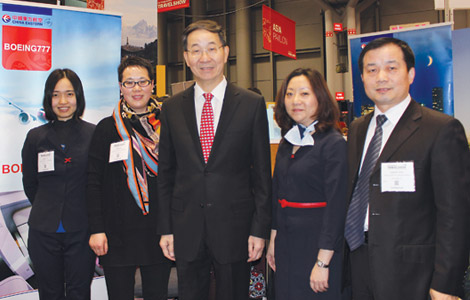Language is better learned in casual study, scholars say
Updated: 2014-03-06 08:19
By Wang Hongyi in Shanghai (China Daily USA)
|
||||||||
International scholars at a conference held in Shanghai on the science of learning suggest an easier, more active way for children to learn a second language than traditional rote memorization in a classroom.
The answer lies in informal learning environments where students not only connect with real life but connect with it in more than one language.
English courses in China have long been criticized for what has been characterized as their dried-up teaching methods and absence of practical application.
Yet studies show that about 81.5 percent of a person's life is spent in informal learning environments. With that in mind, language learning should not be limited to a formal classroom or to a single language, the experts say.
"They should learn English through more active communication, rather than focusing on vocabulary and grammar. It is a way to learn multiple languages," said Dirk Van Damme, head of the innovation and measurement division of the education directorate of the Organization for Economic Cooperation and Development in Paris.
"The ability to speak and communicate is very important. And bilingualism can help stimulate the development of the brain. Chinese students - at least those in Shanghai - are very capable in their second-language learning," Van Damme said.
Exposing children to a bilingual environment through informal study is important, said Cheng Kai-ming, a professor of Education at the University of Hong Kong.
"Learning has always been an essential part of human life," Cheng said. "Now we are living in a society with rapid changes, one that is already substantially different from the typical manufacturing base of the past. Therefore, it's prime time to reinterpret learning."
Another expert also saw the value of bilingual learning but offered a caveat.
"The human brain has a remarkable ability to reorganize its structures in response to differences in environmental and behavioral experience, such as educational, social and multicultural learning, or monolingual versus bilingual language learning," said cognitive neuroscientist Laura Ann Petitto, science director of the National Science Foundation's Science of Learning Center.
Bilingual exposure at an early age will produce some positive effects for a child's growth and learning ability, especially in the area of reading. But she also warned that if a child is exposed to two languages or two reading systems simultaneously, it may cause language delay and confusion.
In an academic report, Bilingualism Alters the Brain's White-Matter Microstructure, Patricia Kuhl, a professor at the University of Washington, said that children in bilingual environments demonstrate higher cognitive ability. Experiments showed, for example, that children in a bilingual environment can get toys into a box more quickly than their single-language peers.
In December, the Ministry of Education released a draft reform plan for the national college entrance examination, or gaokao, making it clear that English will be moved from the exam in the future. Provinces and cities across the country are required to work out their own plans under the direction of the ministry.
So far, many regional gaokao reform plans across the country remain undeveloped, but debate continues to swirl about how English is taught.
wanghongyi@chinadaily.com.cn
(China Daily USA 03/06/2014 page4)
Most Viewed
Editor's Picks

|

|

|

|

|

|
Today's Top News
Chinese firm acquires Texas oil, gas company
US to conclude TPP negotiations
Chinese firm buys two new helicopters from US' Bell
Obama releases budget request
Peace quest spurs defense push
US first lady to visit China
Obama, Merkel discuss Ukraine crisis
Obama releases budget request
US Weekly

|

|














